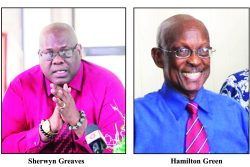Dear Editor,
Both the PPP and the PNC have conceived programmes designed to satisfy the poor’s need for adequate shelter. All over the world people long to own their own home. Owning one’s home is a sign of relative success. Others tend to look at you with a certain level of respect. Ownership of one’s home suggests to others that one is ambitious. As a young man courting a young lady you can do no better to win her parents’ approval than to let them know you have your own home.
But owning a home on the ridiculously low salaries in Guyana is almost impossible. Thus both the PNC and PPP governments have come up, during their varying times in office, with different programmes designed to put in the reach of the poor (I count the public servant among these) the ability to own their own home.
I recall that during the presidency of Mrs Jagan she offered a plan to the people of Tiger Bay to move them to somewhere on the East Bank and somewhere behind Parika on the West Bank. This offer was rejected by the residents. This rejection did not surprise me. It was obvious that the President did not stop to consider that most of the residents of Tiger Bay were unskilled labourers who found work in the city and neighbouring communities. Residents of Tiger Bay therefore would not be able to afford the cost for daily travel from homes and return after work to homes located at the areas proposed by President Jagan. Also, the area behind Parika might be good for farming, I am not sure how she came to the conclusion that these city folks were interested in becoming farmers. But there was another reason that played against the success of the dear president’s plan.
There was a community centre in Tiger Bay (not sure if it is still there) and there was a community officer whose office was located there. I remember talking with him about this rejection of President Jagan’s plan. He told me that in Tiger Bay residents developed close relationships that were important for their survival. He said that since most of the jobs done by residents were not permanent, neighbours had to depend on each other for assistance. Thus when one is out of work one could rely on a neighbour to help with food for example. To move people randomly was to disturb people’s safety net.
In more recent times the PPP has come up with a plan to offer low-income persons land (I don’t know if they are expected to pay for same). However again we see the same lack of thought implicit in this programme. Lowly paid workers struggle to put food on the table. How are they expected to be able to put aside money for purchasing materials and labour for house building? Perhaps one day the PPP will share with the nation how they perceive this being possible.
In the Kaieteur News of 23rd July we read of Miss/Mrs Sandra Hendricks who said she has owned a piece of land for some time but to date could not raise the necessary resources to build a home. For the poor owning land does not equate with owning a home.
I have heard recently that President Ali is proposing a new plan. This time it will target the housing needs of single mothers. The area identified for housing single moms will be somewhere along the Linden highway. At first glance at the limited information on this programme shared with the general society, it does not in any way answer the problems that arose from President Janet Jagan’s proposed programme for residents of Tiger Bay. However, let us wait for the entire plan to be revealed before passing judgement.
On the other hand, in contrast the PNC under President Burnham came up with a programme labelled “the self- help housing programme.” This programme saw low-income workers banding themselves into groups. Each week or monthly, members would place what little they could afford into a common pot. After a year or so groups were able to raise the small amount of monies the Ministry of Housing requested for the clearing of land on which the groups would start building their homes. Material was provided by the Ministry, and building would commence under the supervision and guidance of an experienced ‘foreman’ employed by the said Ministry. This approach to housing the poor had some interesting features.
First, when material was sent to the building site, members of the group took keen interest and would reject material they considered defective. Second, so as to ensure that all the houses were given similar careful attention by group members, no one knew which house would be theirs before all the houses were completed. At which time, the houses would be numbered and each member of the group was invited to draw a number which would indicate the house allotted to them. Third, involving citizens in the building of their own home gave home owners a sense of self pride that cannot be equalled. Few things are of more value to humans than ownership of their own home which they built with their own hands. Fourth, the vast majority of persons obtaining homes by way of the Burnham self-help programme were single mothers, office cleaners, labourers and office assistants. But there were other spinoff benefits.
With self-help groups when a specific group’s turn came around to be allotted land and the allotted land was not pleasing to the group, the group could surrender its position to the group next in line and assume the position of that group on the waiting list. Further, after the drawing of lots and being assigned a house members were free to, swap houses. Many did so because there were persons they preferred to have as immediate neighbour or because of their preference for a particular spot.
Further, building by way of self help allowed participants to learn a trade, thus when later on homes were in need of small repairs home owners would not be saddled with the high cost of employing a skilled carpenter or mason since they could do these things themselves. Also being exposed to the various skills required for building a house offered many self-help group members an opportunity to pursue new forms of employment.
Thus, by way of self-help, housing schemes such as Festival City, Stevedore Housing Scheme, Meadow Brook Housing Scheme, Upper North Ruimveldt Housing Scheme etc were born. Thus, allowing office cleaners, office assistants etc to be able to own their own homes, at a cheap cost since there was no labour cost and they did not have to risk being ripped off by saw mills and unscrupulous contractors.
It would seem to me that any fair-minded examination of these recent approaches at housing the poor would have to conclude that the Burnham self- help programme seems to reflect more thought than all of the programmes undertaken or being contemplated by the present government. Therefore one would think a caring government would embrace at least some of the features of Burnham’s self-help programme as they seeking ways of making housing cheap for low income citizens.
However, we all know the PPP/C government would never contemplate doing such a thing. You see, the self-help approach to housing the poor was a programme conceived by President Burnham and hatred for Burnham give rise to those in the PPP a need to discredit everything he did, even if it means denying the poor some relief.
Yours faithfully,
Claudius Prince







